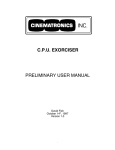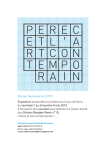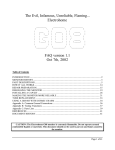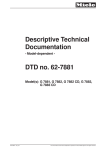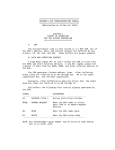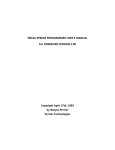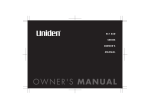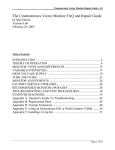Download C.P.U. EXORCISOR PRELIMINARY USER MANUAL
Transcript
C.P.U. EXORCISOR PRELIMINARY USER MANUAL David Fish October 14th, 1997 Version 1.0 1 Table of Contents Overview 3 Cinematronics Exorcisor Description 3 Signature Analysis 3 Equipment Necessary 3 Setting up the Equipment 4 HP5004A Self-test 4 Connecting the HP5004A Signature Analyzer to the Exorcisor 5 Verifying the Exorcisor output signatures 5 Preliminary CPU Operational Testing 6 Connecting the Exorcisor to the CPU under test 7 Reading Signatures and Verification Detecting faulty devices 7 Testing the board for non-JMI mode 8 Testing the board’s RAM addressing signatures 8 Tips & Techniques 8 Appendix A Listing of Signatures for IC pins 9 B Board Layout with marked connection locations 23 C Reference 24 2 OVERVIEW The Cinematronics C.P.U. Exorcisor The Cinematronics Exorcisor was designed to help Test Technicians diagnose circuit faults in the main logic board, a.k.a. CPU, used in all the early Cinematronics Vector based arcade games. The Exorcisor connects to the board under test and injects digital signals into a number of circuit nodes forcing the board to operate in a stable and repeatable manner. With the board in this state the technician can diagnose many component failures by simply reading the digital signatures present on the board and comparing them to the correct signatures which are shown on the schematics. Debugging becomes a simple matter of finding the device which is causing the incorrect signature and replacing it. Signature Analysis From the HP Test & Measurement catalog, here’s a description of Signature Analysis: Signature analysis is a fast and accurate method of troubleshooting digital circuits. Finding faults is reduced to tracing signal flow and comparing measured signatures to printouts or computer-stored signatures. A signature is a 16 bit-cyclic redundancy code (CRC) generated for blocks of data. Instead of entire bit streams, only signatures are compared to detect errors. HP’s patented signature analysis technique enables the HP5005B or HP5006A to generate a compressed, four-digit ‘fingerprint’ or signature of a digital data stream at a logic node. Any fault associated with a device connected to the node will force a change in the data stream and produce an erroneous signature. In other words, a signature is a four digit Hexadecimal representation a binary pattern measured within a ‘window’ defined by a START and a STOP signal. The signatures that are used as a reference were measured on a ‘known-good’ PC board similar to the board under test (DUT). The reference board and the DUT must be driven by identical signal patterns, or exercised, to obtain the proper results. This is just what the Exorcisor does. Equipment Necessary • Signature Analyzer (HP5004A, HP5006A, Atari Cat Box, etc.) • +5 Volt DC @ 5A Power Supply or Cinematronics Power Supply • 100 MHz or higher Oscilloscope w/probes • 2 ½ - Digit or better Digital Multi-meter (DMM) w/leads • 16 pin DIP Clip • Ball Clip or E-Z Hook clip leads, various lengths • Cinematronic CPU Schematics w/signatures 3 SETTING UP THE EQUIPMENT HP5004A Self-Test This section covers the Self-Test feature of the HP5004A. If you are using a different type of Signature Analyzer you must refer to it’s user manual for the Self-test operation. 1. Remove the grabber connectors from the pod test leads, and connect the pod (START, STOP and CLOCK) leads to the matching START, STOP and CLOCK receptacles on the 5004A front panel. 2. Connect the 5004A data probe to the PROBE TEST receptacle on the 5004A front panel. Push the probe tip point gently and firmly into the PROBE TEST receptacle until the point is help securely. 3. Connect the 5004A power cable to the correct power source and set the 5004A front panel as follows: Test A Switch Settings: START: IN STOP: IN CLOCK: IN or OUT Displays: Four seven-segment: UP73 then ACA2 Gate: flickers Unstable Signature: flickers except when good signature is on Probe tip light: Flickers when “ACA2“ is on Test B Switch Settings: START: OUT STOP: OUT CLOCK: IN or OUT Displays: Four seven-segment: 3951 then 2P61 Gate: flickers Unstable Signature: flickers except when good signature is on Probe tip light: Flickers when “2P61“ is on Note In SELF-TEST mode, the seven-segment displays first have all seven segments lit dimly for about 1 second (tests all segments) and then have one of the signature sets listed above for about 1 second. If the probe RESET switch is pressed during the SELF-TEST mode, the four 7-segment-digit displays will show all zeros except when all segments are dimly lit. 4 Connecting the HP5004A Signature Analyzer to the Exorcisor 1. Connect the 5004A’s grabber connectors as follows: CLK (yellow) clip to Exorcisor CLK terminal, START (green) clip to Exorcisor START/STOP terminal, STOP (red) clip to Exorcisor START/STOP terminal, GND (black) clip to Exorcisor GND terminal. 2. Connect The Exorcisor’s +5V banana jack to the 5 volt source, either from the Cinematronics power supply or a lab supply. In the same manner connect the GND banana jack to the supply’s GROUND connection. Verify that the board under test is connected to the +5 volt supply also. 3. Using a short jumper lead connect the Exorcisor’s CLK terminal to the CLK test point on the logic board. This point is located between IC’s Jx and Kx and is marked CLK on the component side of the board. At this point the Exorcisor has all the necessary inputs connected to perform an operational verification test. If this test is not necessary skip the next section. Verifying the Exorcisor output signatures With the equipment connected as described in the previous section apply power to the +5V power supply. Verify that the supply is still putting out +5.0 volts DC ± 0.25VDC. Set the switches on the signature analyzer as follows: HP5004A Switch Settings: START: STOP: CLOCK: IN (negative edge) OUT (positive edge) OUT (positive edge) With the analyzer’s data probe verify the following signatures at the specified locations: DIP plug D8 pin #4 #5 #9 #10 #11 #14 #15 #16 signature 7825 655C 802H 6PF3 8UC2 2518 0000 U6HH 5 Verifying the Exorcisor output signatures (cnt’d) DIP plug U14 pin #9 #10 #11 #12 #13 #14 #15 #16 signature 5555 CCCC 7F7F 5H21 0AFA UPFH 52F8 HC89 DIP clip N2 pin #4 #7 #9 #12 signature F469 PH6F 211U H28U DIP clip R2 pin #4 #7 #9 #12 signature A69C 47F6 8CC5 510F Dip clip T2 pin #4 #7 #9 #12 signature 615F A928 A29F 96FC Preliminary CPU Operational Testing There is a certain minimum operation level which the CPU board must meet before the Exorcisor can be used for fault diagnostics. The 20MHz oscillator circuit (IC-I2, XTAL, R2, R3 and C59) must be operating. The IC’s H2 (74S113) and J4 (74265) must also be operational and generating the four clock signals CLK1, /CLK1, CLK2 and /CLK2. Refer to Sheet 1 of the schematics and, with the oscilloscope, verify that these clock signals are present. Note that the CLK1 signal’s amplitude will be attenuated when the Exorcisor is connected, this is normal. The signal ‘POWER_UP’ at IC B6 pin 2 (74LS04) must be at a TTL High (Vo ≥ 2V). If these requirements are not met the Exorcisor will not operate. These circuits must be repaired before the Exorcisor can be used. 6 Connecting the Exorcisor to the Board Under Test IMPORTANT! Before you connect the Exorcisor verify that the 5 volt power supply is turned OFF! Connecting the Exorcisor to the CPU is a simple task. First disconnect the ribbon cable which connects to the display. Then remove the two 16-pin DIP shunts located at D8 and U14. Connect the DIP plug at the end of the cable which plugs into J3 of the Exorcisor into the IC socket at D8. Connect the other DIP plug at the end of the cable which plugs into J1 into the socket at U14. Attach the DIP clip designated N2 to the IC-N2 (74LS257) paying close attention to the location of pin 1. Attach the R2 DIP clip to IC-R2 and the T2 DIP clip to IC-T2. There is a flying ball-clip connected to the cable from J1, this clip is attached to the test point TP8. No IC’s need to be removed from the board in order to use the Exorcisor. READING SIGNATURES AND VERIFICATION With the equipment hooked up as described in the previous sections turn on the power to the analyzer and the DC power supply. Set the Signature Analyzer to the configuration shown below. Debugging is now a simple matter of touching the probe tip to a specific IC pin and comparing it’s signature to that shown on the schematic. The expected signatures are listed in Appendix A for reference. The key below defines the terms used in the tables. HP5004A Switch Settings: START: STOP: CLOCK: IN (negative edge) OUT (positive edge) OUT (positive edge) NOTE: Some circuit nodes have two signatures shown, the upper (first) value is read when the CLOCK is positive edge triggered and the lower (second) value when the CLOCK is negative edge triggered. Detecting faulty devices In most cases detecting a defective device is as simple as finding a bad signature and finding the IC which is driving the node. Once you find a bad signature follow the signal ‘up-stream’ to the first IC at which a bad signature shows up at. If all the input signatures to this IC are correct and the output is not there a good chance you’ve found a bad device. This reasoning may not lead to a correct determination if, for instance, there is a short affecting the bad node or if an IC connected to the node has a shorted input. It’s 7 always a good idea to check the node in question with a meter and an oscilloscope to help further diagnose a problem. Testing the board for Non-JMI mode Some of the signatures listed in Appendix A are shown within two forward slashes (/nnnn/). These are signatures read when the board has been put in the non-JMI mode. The JMI jumper must be removed, if present, to obtain these signatures. Be sure to replace this jumper when testing has been completed. Testing the board’s RAM Addressing Signatures There are eight unique signatures in Appendix A shown with an asterisk (∗) prefix. These are the signatures for the eight RAM address lines, A0 thru A7. To obtain these signatures pin 10 of IC I12 and pin 10 of IC J12 must be tied to ground. These pins are connected together by a trace so it’s only necessary to ground one. This can be done simply by using a 16-pin DIP clip with pins 10 and 8 tied together and placing the clip on either IC I12 or J12. Tips & Techniques The IC’s on the Cinematronics CPU board have reference designations that correspond to their X and Y position on the board. The grid lines are designated U thru A across the wide dimension (horizontal if the board is positioned with the connectors along the top) and 2 thru 14 across the shorter (vertical) width. Unfortunately, there are no reference designations shown on the board for each IC. To speed up the debug process I highly recommend placing a small label on various IC’s and marking them with it’s reference designation and the number of pins the IC has. The small (5/8” x 3/16”) IC labels that are available in 8 ½” X 11” sheets with 480 labels each are ideal. Always check the test point marked C3-2P first. This is the RESET node and it’s signature should be ‘C32P’. If the signature is incorrect repair the reset circuit before continuing. Always trace bad signatures in the opposite direction of the signal flow. A good starting point is at the X and Y data output latches and the line intensity control circuit. A bad signature at an input of an IC will not always cause a bad signature at it’s output. An inverted signal will always have the same signature as it’s non-inverted source signal. 8 Appendix A Schematic: SHT1 Schematic: SHT2 IC # PIN # IC TYPE SIGNATURE IC # PIN # IC TYPE SIGNATURE B4 B4 B4 B4 E4 E4 E4 E4 E4 F4 F4 F4 F4 D4 B6 B6 C4 F6 F6 F6 F6 A6 A6 A6 B6 B6 F2 F2 F2 F2 F2 F2 F2 F2 F2 F2 F2 F2 F2 13 11 1 6 7 11 10 9 5 9 10 11 8 5 11 10 5 9 10 11 8 8 9 10 13 12 1 2 3 13 14 4 5 6 7 9 10 11 12 74LS00 A328 A328 Lo Hi 49P2 PH07 29A9 80HP 49P2 49P2 392C 392C A522 A522 392C 392C 392C 49P2 A522 392C Lo Lo 9069 9069 H28U H28U PH07 29A9 80HP H28U 0000 FH1H 54P5 8CAU 2043 A941 A328 C9UC 82CU T2 T2 T2 T2 T2 T2 T2 T2 T2 T2 T2 T2 T2 T2 R2 R2 R2 R2 R2 R2 R2 R2 R2 R2 R2 R2 R2 R2 N2 N2 N2 N2 N2 N2 N2 N2 N2 N2 N2 1 2 5 11 14 3 6 10 13 15 4 7 9 12 1 2 5 11 14 3 6 10 13 15 4 7 9 12 1 2 5 11 14 3 6 10 13 15 4 74LS257 49P2 HAFA UAC5 651H F567 F6A4 HA32 F97P 0C22 Hi 615F A928 A29F 96FC 49P2 9172 711H FPF2 HAC9 P38A 30CC FUC5 725C Hi A69C 47F6 8CC5 510F 49P2 26PP 67HU 166U C432 OU1F 0841 242C AC5H Hi F469 74LS151 74LS10 74LS151 74LS04 74LS151 74LS27 74LS02 74LS04 74LS259 9 74LS257 74LS257 Appendix A (cnt’d) Schematic: SHT2 IC # PIN # IC TYPE SIGNATURE IC # PIN # IC TYPE SIGNATURE N2 N2 N2 7 9 12 74LS257 PH6F 211U H28U 12 13 11 9 10 11 3 4 5 6 10 9 7 2 12 13 14 15 3 4 5 6 10 9 7 2 12 13 14 15 3 4 5 6 10 74LS32 7P23 49P2 7P23 clk1 F1CH 7P23 1C14 8236 304P FC6A 2H8F C5F6 HAFA 9172 HAFA UAC5 651H F567 F43F 5000 34CP 66UU 2H8F C5F6 F567 26PP 9172 711H FPF2 HAC9 9115 61CA 91CC 6121 2H8F 9 7 2 12 13 14 15 1 2 3 4 5 6 9 10 8 3 4 5 3 4 5 6 10 9 7 2 12 13 14 15 3 4 5 6 10 9 7 74LS194 K2 K2 K2 L2 L2 L2 T4 T4 T4 T4 T4 T4 T4 T4 T4 T4 T4 T4 R4 R4 R4 R4 R4 R4 R4 R4 R4 R4 R4 R4 N4 N4 N4 N4 N4 N4 N4 N4 N4 N4 N4 N4 J6 J6 J6 J6 J6 J6 J6 J6 J6 L2 L2 L2 S4 S4 S4 S4 S4 S4 S4 S4 S4 S4 S4 S4 P4 P4 P4 P4 P4 P4 P4 C5F6 HAC9 Lo 26PP 67HU 166U C432 7P23 C432 0A76 F6A4 41UC FC5H FC5H 0A76 F12C 49P2 F1CH clk2 1C14 8236 304P FC6A 2H8F C5F6 F12C P38A F6A4 HA32 F97P 0C22 F43F 5000 34CP 66UU 2H8F C5F6 0C22 74LS10 74LS194 74LS194 74LS194 10 74LS00 74LS10 74LS194 74LS194 Appendix A (cnt’d) Schematic: SHT2 & SHT3 SHT3 IC # PIN # IC TYPE SIGNATURE IC # PIN # IC TYPE SIGNATURE P4 P4 P4 P4 P4 M4 M4 M4 M4 M4 M4 M4 M4 M4 M4 M4 2 12 13 14 15 3 4 5 6 10 9 7 12 13 14 15 74LS194 0U1F P38A 30CC FUC5 725C 9115 61CA 91CC 6121 2H8F C5F6 725C 0U1F 0841 242C AC5H 3 4 5 6 9&10 12 13 14 15 3 4 5 7 10 11 12 13 14 15 3 4 5 74LS194 7 10 11 12 13 14 15 1 2&3 4 20 9 11 13 15 1 2 3 4 5 6 7 21 20 9 11 13 15 1 2 3 4 5 6 7 21 20 9 11 74LS298 H12 H12 H12 H12 H12 H12 H12 H12 H12 J12 J12 J12 J12 J12 J12 J12 J12 J12 J12 I12 I12 I12 I12 I12 I12 I12 I12 I12 I12 E12 E12 E12 N14 N14 N14 N14 N14 N14 N14 N14 N14 N14 N14 N14 N14 M14 M14 M14 M14 M14 M14 M14 M14 M14 M14 M14 M14 M14 L14 L14 L14 PH07 AAP8 0000 ∗F6C6 ∗402U ∗01F4 ∗PPC3 4A50 4A50 4A50 4A50 96FC A29F A928 615F ∗0038 ∗6034 ∗UCCC ∗PF3C ∗PPC3 ∗01F4 ∗402U ∗F6C6 4A50 510F 8CC5 47F6 A69C ∗0038 ∗6034 ∗UCCC ∗PF3C ∗PPC3 ∗01F4 ∗402U ∗F6C6 4A50 H28U 211U 74LS194 74LS298 74LS298 392C 80HP 29A9 PH07 CH9A 0PH1 54CC H255 7H33 7H33 H255 54CC 0PH1 AAP8 0000 ∗PF3C ∗UCCC ∗6034 ∗0038 392C 80HP 29A9 11 74LS04 9101C 9101C 9101C Appendix A (cnt’d) Schematic: SHT3 IC # PIN # IC TYPE SIGNATURE IC # PIN # IC TYPE SIGNATURE L14 L14 L14 L14 L14 L14 L14 L14 L14 L14 N11 N11 N11 N11 N11 N11 N11 N11 N11 M11 M11 M11 M11 M11 M11 M11 M11 M11 L11 L11 L11 L11 L11 L11 L11 L11 L11 H10 H10 13 15 1 2 3 4 5 6 7 21 3 6 10 13 15 4 7 9 12 3 6 10 13 15 4 7 9 12 3 6 10 13 15 4 7 9 12 4 5 9101C PH6F F469 ∗0038 ∗6034 ∗UCCC ∗PF3C ∗PPC3 ∗01F4 ∗402U ∗F6C6 392C 80HP 29A9 PH07 4UHF 8C81 C428 9AC5 67C8 37C1 HP4P P75P A6HF 3P10 C781 6C47 A8H3 0PF5 392C 80HP 29A9 PH07 7323 P9UF A996 6HF3 76F5 9069 76F5 H10 N9 N9 N9 N9 N9 N9 N9 N9 N9 N9 N9 N9 N9 M9 M9 M9 M9 M9 M9 M9 M9 M9 M9 M9 M9 L9 L9 L9 L9 L9 L9 L9 L9 L9 L9 N6 N6 N6 6 1 2 3 4 9 10 11 12 13 14 15 5 6 1 2 3 4 9 10 11 12 13 14 15 5 1 9 10 11 12 13 14 15 5 6 1 2 3 74LS32 74LS85 P6AF 8C81 9398 9686 051P 1776 H9P9 9AC5 A29F A928 C428 615F A197 237P 67C8 0PF5 Lo 510F A8H3 8CC5 6C47 47F6 A69C C781 96FC H9P9 P9UF 96AF H28U 6HF3 211U PH6F A996 F469 051P 9686 67C8 96FC 60P1 74LS157 74LS157 74LS157 74LS32 12 74LS85 74LS85 25LS181 Appendix A (cnt’d) Schematic: SHT3 IC # PIN # IC TYPE SIGNATURE IC # PIN # IC TYPE SIGNATURE N6 N6 N6 N6 N6 N6 N6 N6 N6 N6 N6 N6 N6 N6 N6 N6 N6 M6 M6 M6 M6 M6 M6 M6 M6 M6 M6 M6 M6 M6 M6 M6 M6 M6 M6 M6 M6 L6 L6 4 5 6 7 8 18 19 20 21 22 23 9 10 11 13 15 17 1 2 3 4 5 6 7 8 18 19 20 21 22 23 9 10 11 13 15 17 1 2 25LS181 60P1 211A HC91 H3UF 41UC 8C81 615F C428 A928 9AC5 A29F 1C14 8236 304P FC6A 7A6F 3H1C 0PF5 510F 60P1 60P1 211A HC91 2632 41UC C781 A69C 6C47 47F6 A8H3 8CC5 F43F 5000 34CP 66UU 6023 70AF P6AF H28U L6 L6 L6 L6 L6 L6 L6 L6 L6 L6 L6 L6 L6 L6 L6 L6 L6 L6 U2 U2 K2 K2 K2 K2 K2 K2 K4 K4 K4 J8 J8 J8 3 4 5 6 7 8 18 19 20 21 22 23 9 10 11 13 15 17 9 8 4 5 6 9 10 8 2 3 1 1 2 3 25LS181 60P1 60P1 211A HC91 9A6A 41UC P9UF F469 A996 PH6F 6HF3 211U 9115 61CA 91CC 6121 235P 21H0 9A6A 9A6A 41UC 9A6A 60P1 9A6A 41UC 211A 41UC 9A6A 60P1 41UC 9A6A HC91 U9 U9 T9 T9 4 & 13 4 & 13 4 & 13 4 & 13 74LS75 25LS181 25LS181 13 74S04 74LS32 74LS02 74LS86 74LS75 0000/H33C [5A4H] 0000/H33C [5A4H] Appendix A (cnt’d) SHT4 IC # PIN # IC TYPE SIGNATURE IC # PIN # IC TYPE SIGNATURE U11 U11 T11 T11 T13 T13 T13 T13 T13 T13 T13 T13 T13 T13 T13 T13 T13 T13 T13 T13 T13 S13 S13 S13 S13 S13 S13 S13 S13 S13 1 15 1 15 1 3 4 7 8 13 14 17 18 2 5 6 9 12 15 16 19 1 2 5 6 9 12 15 16 19 74LS157 90AP C32P 90AP C32P 802H HC89 UPFH 5H21 CCCC 5555 7F7F 0AFA 52F8 6H37 1F1A 4C4H 4819 5547 1106 8884 C004 6PF3 PH07 29A9 80HP 392C A6HF P75P HP4P 37C1 J14 J14 J14 H14 H14 H14 I14 I14 I14 I14 I14 I14 I14 I8 I8 I10 I10 I10 H14 H14 H14 H14 H14 H14 H14 H14 I8 I8 3 4 5 2 3 1 1 3 6 9 7 & 10 11 12 9 8 13 12 11 11 12 13 9 8 10 5 4 3 4 74S288 P503 C15P 90AP P503 U646 FU1U C32P H666 FU3U FU1U 891F 6069 891F 891F 891F 19AP 6069 6909 5278 6909 H33C H33C 891F 07U2 H33C 0000 / H33C 2518 2518 J14 J14 J14 J14 J14 J14 J14 10 11 12 13 14 1 2 74S288 J4 J4 J10 J10 J10 J10 J10 J10 1 2 1 4 12 13 3 2 74LS157 74LS377 74LS377 655C 7825 6PF3 390P 19AP H666 FU3U 74S02 74LS163 74LS04 74S00 74S02 74LS04 74265 74LS107 578F 578F 54CC 0PH1 FFC9 C32P 473U 473U Appendix A (cnt’d) Schematic: SHT4 IC # PIN # IC TYPE SIGNATURE IC # PIN # P13 P13 3 4 74LS194 P6AF 6HF3 R11 R11 5 6 14 IC TYPE SIGNATURE UHUH U095 P13 P13 P13 P13 P13 P13 P13 R13 R13 R13 R13 R13 R13 R13 R13 R13 R13 R13 R13 R13 R13 R13 R13 S11 S11 S11 S11 S11 S11 S11 S11 S11 S11 S11 S11 R11 R11 5 6 9 & 10 12 13 14 15 3 4 7 8 13 14 17 18 2 5 6 9 12 15 16 19 3 4 5 6 1 2 9 7 11 12 13 14 3 4 74LS377 74LS163 74LS163 A996 P9UF FP22 480P 70F4 98A7 H9FP 0PF5 A8H3 6C47 C781 67C8 9AC5 C428 8C81 9UCC P6A0 UHUH U095 2788 1533 42P0 9U76 H9FP 98A7 70F4 480P C32P clk1 390P C15P 99F8 2CAP 38P3 5278 9UCC P6A0 R11 R11 R11 R11 P11 P11 P11 P11 P11 P11 P11 P11 S9 S9 S9 S9 S9 S9 S9 S9 S9 R9 R9 R9 R9 R9 R9 R9 R9 P9 P9 P9 P9 P9 P9 P9 P9 15 11 12 13 14 3 4 5 6 11 12 13 14 1 2 5 11 14 4 7 9 12 2 5 11 14 4 7 9 12 2 5 11 14 4 7 9 12 74LS163 74LS157 74LS157 74LS157 9HPH 50HC F0A5 45H9 2788 1533 42P0 9U76 63P6 CC8C C8PU 6865 19AP H28U 211U PH6F F469 155C 7211 8066 HA00 510F 8CC5 47F6 A69C UPAP A7U5 5PF5 FC92 96FC A2F9 A928 615F C443 U62F 0499 578F Appendix A (cnt’d) Schematic: SHT5 IC # PIN # IC TYPE SIGNATURE IC # PIN # IC TYPE SIGNATURE G12 G12 G12 G12 G14 G14 G14 G14 G14 G14 G14 G14 G14 G14 G14 G14 F14 F14 F14 F14 F14 F14 F14 F14 F14 F14 F14 F14 E14 E14 E14 E14 E14 E14 E14 E14 E14 E14 E14 3 4 5 6 2 5 11 14 3 6 10 13 4 7 9 12 1 2 3 4 5 6 7 15 9 10 11 12 10 11 12 13 14 1 2 3 4 5 6 74S10 C004 8884 1106 U24U 6H37 1F1A 4C4H 4819 5547 1106 8884 C004 2293 62C7 P68U 283P 9673 51C4 U24U 283P 2293 62C7 P68U 2518 1846 FP05 8399 61C3 2293 62C7 P68U 283P U24U 0C45 320U C530 1P02 394A 8PP6 E14 E14 D14 D14 D14 D14 D14 D14 D14 D14 C14 C14 C14 C14 C14 C14 C14 C14 E10 E10 E10 E10 D10 7 9 1 2 3 4 5 6 7 9 1 2 3 4 5 6 7 9 9 7 13 14 1 74S288 409C 07PU 2H8F A76P 41UC 7P23 9A6A 5H61 8ACC 5AA5 9069 7323 CH9A 96UA 67AH 2PFF 32U4 U100 802H 8UC2 9673 51C4 7341 B6 B6 A8 A8 A8 G10 G10 G10 G10 G10 G10 G10 G10 G10 9 8 8 11 5 3 4 5 6 9 & 10 12 13 14 15 74S158 74S287 74S288 16 74S288 74S288 74LS163 74LS04 74LS107 74LS194 615F 615F [0000] 615F [0000] 615F [0000] 30AP [Hi] A197 2379 AH4H AC5H F1CH 0F96 4U54 8233 8H73 Appendix A (cnt’d) Schematic: SHT5 IC # PIN # IC TYPE SIGNATURE IC # PIN # IC TYPE SIGNATURE U7,R7 T7,P7 “ “ “ “ “ “ “ “ “ “ “ “ 1 2 3 4 5 6 7 8 18 19 20 21 22 23 ROM C443 FC92 5PF5 A7U5 UPAP HA00 8066 7211 473U 578F Lo Lo 0499 U62F 8 11 5 6 3 9 15 11 12 13 14 9 15 11 12 13 14 9 11 12 13 14 4 7 74LS107 9 12 4 7 9 12 4 7 9 12 4,13 13 1 2 3 1 5 4 11 12 13 10 7,10 11 12 1 2 3 4 5 6 7 8 19 22 23 74LS157 A8 A8 A8 F10 A12 S11 S11 S11 S11 S11 S11 R11 R11 R11 R11 R11 R11 P11 P11 P11 P11 P11 S9 S9 S9 S9 R9 R9 R9 R9 P9 P9 P9 P9 U9,T9 J14 J14 J14 J14 H14 H14 H14 H14 H14 H14 H14 I14 I14 I14 U7,R7 T7,P7 “ “ “ “ “ “ “ “ “ / 1285 / / UUF5 / / 0A1F / / H162 / / FF86 / / FA45 / / 4473 / / 3124 / / A8PF / / 4U1H / / 5AH4 / / 2AF1 / / 86F5 / / UUPU / / A9P3 / / 83UU / / 5AH4 / / 5AH4 / / A98H / / 8P9C / / 5AH4 / / HOU8 / / 6HH2 / / 87UC / / 6HH2 / / 4473 / / FA45 / / FF86 / / H162 / / 0A1F / / UUF5 / / 1285 / / U801 / / 4U1H / / A8PF / / 3124 / 74LS151 74LS32 74LS163 74LS157 / 0000 / / 0000 / / Hi / / 61H3 / / 2AF1 / / 2AF1 / / 2F0H / / 73HU / / F745 / / 2AF1 / / HA98 / / P781 / / 8HA7 / / AC18 / / F55H / / 2AF1 / / 7C77 / / 17UP / / C962 / / 9855 / / 9515 / / U801 / 17 74LS157 74LS157 74LS75 74S288 74S02 74LS163 PROMS Appendix A (cnt’d) Schematic: SHT5 IC # PIN # IC TYPE SIGNATURE IC # PIN # IC TYPE SIGNATURE F10 F10 F10 F10 F10 F10 F10 F10 F10 F10 A12 A12 3 2 1 9 10 11 13 14 15 6 2 3 74LS151 30AP [ Hi ] 018F 8H73 4C4H 1F1A 6H37 0F96 4U54 8233 F384 [61H3] 67AH 390P [2AF1] 9 10 8 10 11 5 6 1 4 2 74LS08 11 12 13 1 4 2 3 12 13 3 11 8 10 6 5 74LS08 74LS02 C10 C10 C10 B8 B8 B8 B8 B8 B8 B8 C10 D10 D10 A8 A8 A8 A8 C8 C8 C8 C8 C8 C8 C8 C8 Lo C32P C32P 32U4 802H 49P2 49P2 U6HH C32P 9081 665F C32P Hi C32P C32P E12 E12 A10 A10 A10 D12 D12 D12 D12 D12 D12 D12 D12 B10 B10 5 6 9 10 8 3 4 5 6 9 10 11 8 13 11 F12 F12 F12 F12 F12 I10 D10 D10 F12 F12 F12 F12 D10 D10 D10 A14 A14 A14 B12 B12 B12 A12 1 2 4 5 6 3 5 4 10 12 13 8 8 9 10 1 2 3 9 11 8 6 74LS32 74LS107 74LS04 74LS00 74LS27 74LS32 2PFF 7341 U646 C32P 6PF3 19AP 19AP 409C 802H 4A50 5547 5547 2518 51C4 36C4 4819 67AH 36C4 Lo 5547 36C4 8PP6 Lo 32U4 32U4 18 74LS107 7425 74LS00 74LS02 7425 74S08 74LS10 74LS32 6H37 4819 1F1A FC4H 8884 0000 / PC9U 67AH FFC9 8884 C004 2518 774P 774P 6598 ~12H6~ 51C4 32U4 12A8 2518 0F96 C05P A76P Appendix A (cnt’d) Schematic: SHT5 SHT6 IC # PIN # IC TYPE SIGNATURE IC # PIN # IC TYPE SIGNATURE K4 K4 K4 C12 C12 C12 C12 C12 C12 C12 C12 C12 B12 B12 B12 B12 A10 A10 A10 A10 A10 A10 A10 A6 A6 A6 A14 A14 A14 A12 A12 B14 B14 B14 B14 B14 B14 B14 8 9 10 1 2 12 3 4 5 6 10 8 3 4 5 6 12 11 4 5 6 1 3 5 6 4 4 5 6 10 8 9 8 1 2 3 5 6 74LS02 CUH7 0UHA AA31 1P02 2518 C4AF 2518 U6HH 96UA H47A 774P 1798 C32P FP05 1798 077H 802H 802H 1798 1846 7890 6PF3 6PF3 1846 U100 AAP8 320U 7341 F567 0C45 FP22 F567 4UHF 774P 7323 UC77 F567 3P10 H8 H8 H8 I8 G8 G8 F8 F8 F8 F8 B6 H8 H8 H8 H8 H8 H8 G8 G8 G8 A12 A12 A12 I8 H8 J8 J8 J8 J8 J8 J8 F6 F6 I8 H6 J6 J2 J2 J2 5 6 4 12 4 2 9 7 1 15 4 11 12 13 8 9 10 11 5 6 12 13 11 2 1 9 10 8 12 13 11 3 6 10 13 11 3 12 11 74LS02 C530 5547 403F 403F 6598 239A C530 F9U6 C32P F9U6 F9U6 F9U6 239A U97A 5547 C530 U50F 0109 018F 018F 018F F9U6 204A 204A 3980 F97P F6A4 0UHA 651H HAFA CUH7 1P02 6598 6598 9820 9820 9820 C9UC 2873 74LS27 74LS10 74LS00 74LS02 74S08 74LS32 74S32 19 74LS04 74LS107 74LS163 74LS04 74LS02 74LS107 74LS32 74LS04 74LS02 74LS86 74LS27 74LS04 74LS164 74LS10 74LS32 74LS32 Appendix A (cnt’d) Schematic: SHT6 IC # PIN # IC TYPE SIGNATURE IC # PIN # IC TYPE SIGNATURE E8 E8 E8 E8 E8 E8 E8 E8 E8 E8 E8 E8 E6 E6 E6 E6 E6 E6 E6 E6 D6 D6 D6 D6 D6 D6 C6 C6 C6 C6 C6 C6 C6 10 11 12 13 14 1 2 3 4 5 6 7 1 7 9 11 12 13 14 15 6 11 12 13 14 15 3 4 11 12 13 14 15 74S288 A8F6 90P2 7U69 A19U 0495 5C13 26U2 1825 9890 AUH7 673F FH67 403F 3980 6598 90P2 9620 9170 A8F6 049C A3U1 PF0A A19U 7U69 FA81 CH8U 1P24 0495 H3PU 0495 1P24 A3U1 0109 S2 S2 S2 S2 S2 S2 S2 S2 S2 S2 S2 S2 S2 S2 S2 S2 P2 P2 P2 P2 P2 P2 P2 P2 P2 P2 P2 P2 P2 P2 P2 P2 P2 M2 M2 M2 M2 M2 M2 4 14 13 17 3 7 8 18 5 15 12 16 2 6 9 19 1 4 14 13 17 3 7 8 18 5 15 12 16 2 6 9 19 1 4 14 13 17 3 74LS377 F6A4 HA32 F97P 0C22 HAFA UAC5 651H F567 6P3U 6P3U 8A2A 6P3U 3796 3796 U366 1H2A C530 P38A 30CC FUC5 725C 9172 711H FPF2 HAC9 6P3U 0000 P415 6P3U 2ACF 1H2A C7P5 AA58 C530 OU1F 0841 242C AC5H 26PP U2 U2 U2 U2 S2 11 10 13 12 1 74LS163 74LS163 74LS163 74S04 74LS377 F6A4 F6A4 HAFA HAFA C530 20 74LS377 74LS377 Appendix A (cnt’d) Schematic: SHT6 IC # M2 M2 M2 M2 M2 M2 M2 M2 M2 M2 M2 ------- PIN # IC TYPE SIGNATURE 7 74LS377 67HU 8 166U 18 C432 5 8A2A 15 6P3U 12 8A2A 16 0000 2 0000 6 C7P5 9 PP4F 19 0000 ----------- ----------------- --------------------- 21 IC # PIN # IC TYPE SIGNATURE Key for Appendix A clk1 clk2 Hi Lo nnnn / mmmm ∗nnnn /nnnn/ CLOCK signal, will show 0000 signature CLOCK signal, “ TTL level HIGH, “ TTL level LOW, “ nd Lower (2 ) signature obtained with edge CLK (button IN) Signature obtained with J12 (& I12) pin 10 tied to GND Signature available with NO JMI option (jumper removed) 22 Appendix B 23 Appendix C EXAMPLES OF USEFUL MANUFACTURERS’ LITERATURE Schematic Package #72-10626-02 Rev J, C.P.U. Schematic Diagram with Signatures, Cinematronics Inc. Application Note AN-222-4, Guidelines for Signature Analysis: Understanding the Signature Measurement, Hewlett-Packard Inc., Publication Number 5952-7684. Application Note AN-222-6, Troubleshooting with Composite Signatures, Hewlett-Packard Inc., Publication Number 5952-7684. 24
























